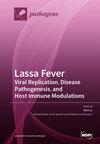与火鸡幼崽神经症状有关的禽脑脊髓炎病毒新变种
IF 3.3
3区 医学
Q2 MICROBIOLOGY
引用次数: 0
摘要
禽脑脊髓炎(AE)是由禽脑脊髓炎病毒(AEV)引起的一种疾病,该病毒属于禽病毒科特雷莫病毒属。最近,南达科他州立大学和明尼苏达大学的兽医诊断实验室接连收到出现神经症状的火鸡病例。受感染的火鸡出现神经症状,如颤抖、无法站立、扭转颈部和翅膀下垂。临床症状在 3 周龄时出现。解剖发现,包括大脑在内的内脏器官没有明显的大体病变。大脑中没有明显的细菌生长。对大脑各部分进行显微镜检查后发现,小脑和大脑皮层的血管周围有多灶性淋巴浆细胞囊肿。对大脑样本进行了处理,以便通过新一代测序技术进行检测和全基因组测序。AEV的三个全长多蛋白序列(6405 nt)被组装起来。这三个序列的核苷酸和氨基酸相似度分别为99.9%-100%和100%。而 GenBank 中与 AEV 野外毒株和疫苗序列的核苷酸相同度仅为 77.7%-78.5%,氨基酸相同度为 90.3%-92.5%。这表明,一种新的AEV分化变异株正在田间流行,并导致了中西部地区的AE爆发。本文章由计算机程序翻译,如有差异,请以英文原文为准。
A New Variant of Avian Encephalomyelitis Virus Associated with Neurologic Signs in Turkey Poults
Avian encephalomyelitis (AE) is a disease caused by the avian encephalomyelitis virus (AEV) of the genus Tremovirus in the family Picornaviridae. Recently, cases of turkey poults showing neurological signs were submitted to the veterinary diagnostic laboratories at South Dakota State University and the University of Minnesota. The affected birds were showing nervous neurological signs such as tremors, inability to stand, torticollis, and wing drop. Clinical signs were observed by 3 weeks of age. Necropsy of birds revealed no significant gross lesions in the internal organs, including the brain. There was no significant bacterial growth in the brains. Microscopic examination of various sections of the brain revealed multifocal lymphocplasmacytic perivascular cuffs in the cerebellum and cerebral cortex. The brain samples were processed for detection and whole genome sequencing by next-generation sequencing. Three full-length polyprotein sequences (6405 nt) of AEV were assembled. All three sequences shared 99.9–100% nucleotide and 100% amino acid identities with each other. Only 77.7–78.5% of nucleotide and 90.3–92.5% of amino acid identities with AEV field strains and vaccine sequences were available in GenBank. This indicates that a new divergent variant of AEV is circulating in the field and causing AE outbreaks in the Midwest region.
求助全文
通过发布文献求助,成功后即可免费获取论文全文。
去求助
来源期刊

Pathogens
Medicine-Immunology and Allergy
CiteScore
6.40
自引率
8.10%
发文量
1285
审稿时长
17.75 days
期刊介绍:
Pathogens (ISSN 2076-0817) publishes reviews, regular research papers and short notes on all aspects of pathogens and pathogen-host interactions. There is no restriction on the length of the papers. Our aim is to encourage scientists to publish their experimental and theoretical research in as much detail as possible. Full experimental and/or methodical details must be provided for research articles.
 求助内容:
求助内容: 应助结果提醒方式:
应助结果提醒方式:


